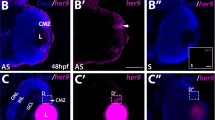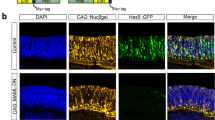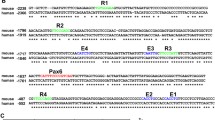Abstract.
The retina is an excellent system in which to study neural cell fate decision mechanisms. It is an organized laminated structure with a limited array of cell types. During the last 5 years, experiments that perturb normal gene expression have highlighted some molecular mechanisms involved in cellular fate choice in the retina. By controlling when a retinoblast is allowed to differentiate, Delta-Notch signaling plays a critical role in the generation of neuronal diversity in the vertebrate retina. When cells are released from the inhibition mediated by the Delta-Notch pathway, basic helix-loop-helix (bHLH) transcription factors act as intrinsic factors that bias neuroblasts towards particular fates. In this review, we present an overview of the data leading to these conclusions on the role of the Delta-Notch pathway and the bHLH proteins on cell fate decisions during vertebrate retinogenesis.
Similar content being viewed by others
Author information
Authors and Affiliations
Rights and permissions
About this article
Cite this article
Perron, M., Harris*, W. Determination of vertebrate retinal progenitor cell fate by the Notch pathway and basic helix-loop-helix transcription factors . CMLS, Cell. Mol. Life Sci. 57, 215–223 (2000). https://doi.org/10.1007/PL00000685
Issue Date:
DOI: https://doi.org/10.1007/PL00000685




